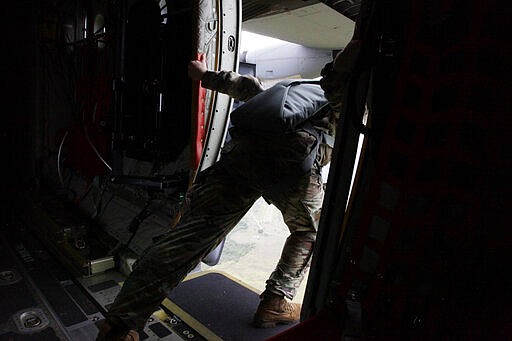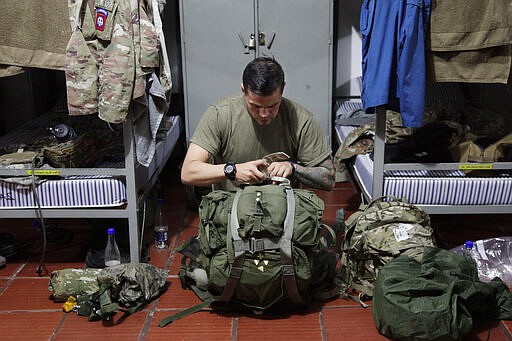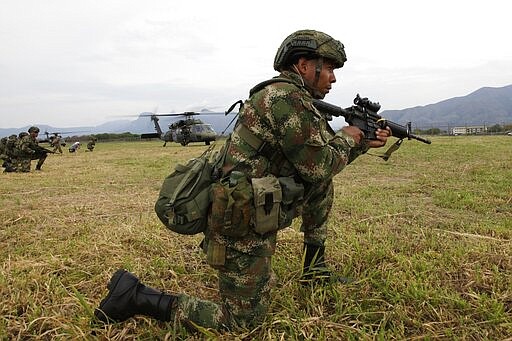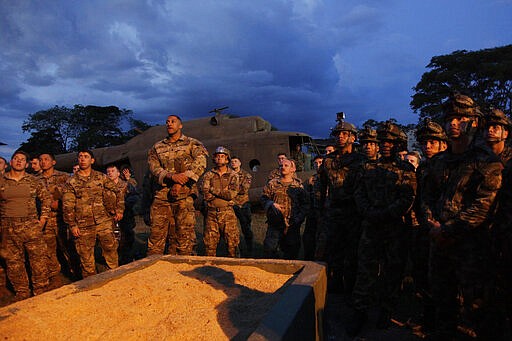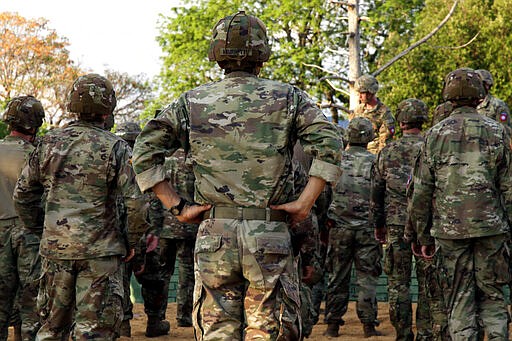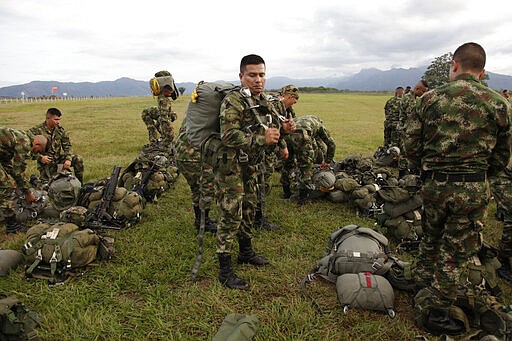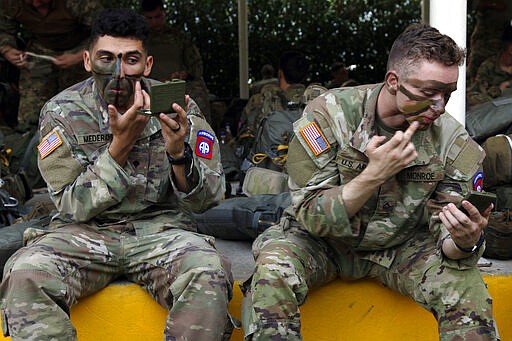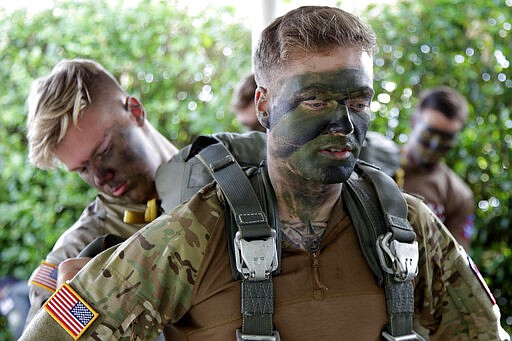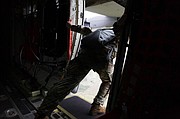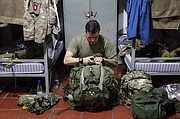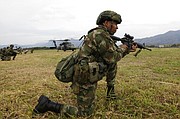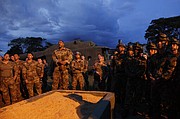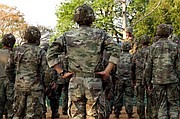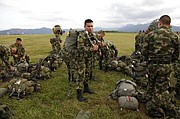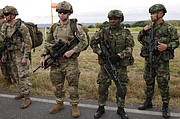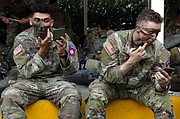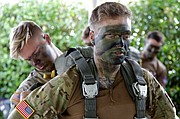Paratrooper exercise is all about preparation - and the jump
TOLEMAIDA AIR BASE, Colombia (AP) — Under a covered pavilion near a steaming runway at Colombia's Tolemaida Air Base, dozens of American paratroopers lie sweating on a concrete slab. Green and brown camouflage face paint drips from their brows.
The soldiers of the 82nd Airborne Division can’t move much — they’re loaded down with rifles and nearly 100 pounds of gear. In less than an hour, it will all drop out of a C-130 aircraft moving 150 mph.
The group's banter quiets to make way for directions from jumpmasters moving from one soldier to the next, making sure buckles and straps are in place.
Spc. Parker Firth is quieter than usual. After 22 jumps, he admits he’s still scared
“When the doors open, it’s not in your hands anymore," the 22-year-old said. "You just got to believe in the parachute to open. Whatever happens happens.”
For these 75 American paratroopers from Fort Bragg, North Carolina, this weeklong training exercise with the Colombian Army is not a deployment — a word reserved for occasions like the New Year’s Eve mobilization that sent members of the division’s Immediate Response Force to the Middle East, amid rising tensions with Iran. For now, 2,500 division paratroopers remain in the Middle East on standby.
It's intense training like the exercise in Colombia that allows the soldiers to deploy with lightning speed. Their readiness inspired the old saying around Fort Bragg: “When the president dials 911, the 82nd?answers the phone.” The division, with nearly 18,000?paratroopers, operates under a constant state of readiness, rotating soldiers on and off standby.
The Associated Press was given rare access to accompany the group on its January joint training mission with Colombia, amid a humanitarian crisis in neighboring Venezuela that has sent hundreds of thousands of migrants and refugees fleeing over the border. U.S. diplomatic and political efforts to replace Venezuelan President Nicolas Maduro with opposition leader Juan Guaido have been unsuccessful.
There have been no signs pointing to potential military intervention by the U.S. or Colombia. But as the United States has spent billions of dollars restoring peace and building a partnership in a region that’s heavily influenced by Russia and Iran, cementing relationships like the one with Colombia is key to U.S. strategy.
U.S. and Colombian forces spend several days mapping out the exercise, which simulates the securing of an air base. They spend hours jumping off elevated wooden platforms and practicing their landings in what resemble oversized sandboxes.
“It’s an honor to jump with the 82nd?Airborne Division,” Colombian?Maj. Gen. Pablo Alfonso Bonilla Vasquez?tells the Americans, adding that their cooperation will send a message to the region.
The night before the jump, Sgt. Juan Dominguez sits on the floor and pulls at a maze of straps on his rucksack. The 33-year-old joined the U.S. Army at 27, later than many of his comrades. It was always a dream, but his wife and five children needed to be taken care of before he enlisted. He said he wants “to show my kids that even though I’m afraid of heights, you can overcome pretty much anything.”
At 4 a.m. on jump day, Sgt. 1st Class Nathan Fair and the soldiers of Bravo Company 325th?Infantry Regiment rise and begin loading their gear onto buses bound for the airfield.
This is Fair’s second stint in the military. The 37-year-old left in 2006 but realized civilian life wasn’t his speed.?“You miss the little things, like how easy it is to fall asleep on a gravel road on the range, with rocks digging into your back and you’re so ridiculously exhausted that you can just fall asleep anywhere,” he said.
Fair calls himself a “super-patriot” and is fiercely proud of the soldiers he leads: “They’re motivated, they’re in shape, they’re funny, they’re quick-witted, they’re aggressive. They’re alpha males and that’s the kind of men you want on the front lines defending you.”
On this mission, only one paratrooper sent from Fort Bragg is a woman — the division, much like the Army, is mostly men. Senior medic Sgt. Sara Sanders grew up hearing about the 82nd's legacy from her father and grandfather, both paratroopers. “Everyone grew up wanting to be professional ballerinas,” she said. “And I was like, ‘No, I want to be in the Army.'”
On jump day, all the members' preparation is put to a test. The soldiers are nervous but calm. (And if any say they aren't, "they're either lying to you or have something wrong upstairs,” Staff Sgt. Wesley Lee says.)
Packed into the C-130, waiting for the flashing green light that tells them it’s time to jump, they are no longer Americans or Colombians. They are just soldiers, focused on their task.
Maj. Gen. Daniel Walrath is first out the door. The jump — his first in 10 years — is a sign of leadership to his soldiers and a symbol of friendship to the Colombian general leading the way through the door on the other side of the airplane.
One by one, Colombian and American paratroopers follow, stepping off the ledge and spiraling downward. As each jumps, a white canopy unfolds above, slowing their fall but not the pace of their breath.
The division declares the exercise a success, with only one minor injury: a broken bone on the Colombian side.
The next day, the troops from both nations gather on Tolemaida Air Base. They have earned the right to wear one another's jump wings. For Fair, this is not just an alliance on paper; it’s a bond among soldiers. “And if it comes to it, and we have to fight together," he said, "they know we’ve got each other’s backs.”
___
Follow Morgan at www.twitter.com/StorytellerSBM



